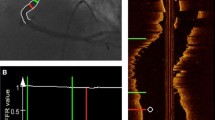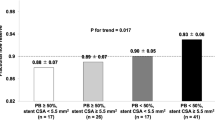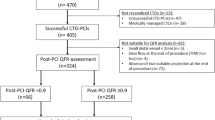Abstract
Scant data exploring potential suboptimal physiological results after angiographic successful percutaneous coronary intervention (PCI) of chronic total occlusion (CTO) are available. Sixty cases of successful CTO-PCI were selected for this retrospective analysis. Post-CTO-PCI angiography-based fractional flow reserve was computed using the Murray-based fractional flow reserve (μFR) software. Vessel-specific μFR, residual trans-stent gradient (TSG) and corrected TSGstent were calculated. In physiological suboptimal results (μFR < 0.90), the virtual pullback pressure gradient (PPG) curves were analyzed to localize the main pressure drop-down and characterize the patterns of residual disease. The virtual pullback pressure gradient index (vPPGi) was then calculated to objectively characterize the predominant pattern of residual disease (diffuse vs focal). The physiological result was suboptimal in 28 cases (46.7%). The main pressure drop was localised proximal to the stent in 2 (7.1%), distal in 17 (60.7%) and intra-stent in 9 cases (32.2%). Intra-stent residual disease was diffuse in 7 cases and mixed in 2. Distal residual disease was characterised by a pure focal pattern in 12 cases, diffuse in 2 and mixed in 3. In the predominant diffuse phenotype (vPPGi < 0.65), we found a higher rate of TSG ≥ 0.04 (61.5% vs 20.0%, p = 0.025) and TSGstent ≥ 0.009 (46.2% vs 20.0%, p = 0.017) while in the dominant focal phenotype poor-quality distal vessel was constantly present. In our cohort, post-CTO-PCI suboptimal physiological result was frequent (46.7%). Predominant focal phenotype was constantly associated with poor-quality distal vessel, while in the predominant diffuse phenotype, the rate of TSG ≥ 0.04 and TSGstent ≥ 0.009 were significantly higher.

Similar content being viewed by others
Data availability
No datasets were generated or analysed during the current study.
Abbreviations
- CTO:
-
Chronic total occlusion
- μFR:
-
Murray-based fractional flow reserve
- PCI:
-
Percutaneous coronary intervention
- TSG,:
-
Trans-stent gradient
- TSGstent :
-
Trans-stent gradient adjusted for total stent length
- vPPGi:
-
Virtual pullback pressure gradient
References
Azzalini L, Carlino M, Bellini B et al (2020) Long-term outcomes of chronic total occlusion recanalization versus percutaneous coronary intervention for complex non-occlusive coronary artery disease. Am J Cardiol 125(2):182–188. https://doi.org/10.1016/j.amjcard.2019.10.034
Kotsia A, Navara R, Michael TT et al (2015) The AngiographiC Evaluation of the everolimus-eluting stent in Chronic Total Occlusion (ACE-CTO) study. J Invasive Cardiol 27(9):393–400
Di Mario C, Mashayekhi KA, Garbo R, Pyxaras SA, Ciardetti N, Werner GS (2022) Recanalisation of coronary chronic total occlusions. EuroIntervention 18(7):535–561. https://doi.org/10.4244/EIJ-D-21-01117
Butala NM, Tamez H, Secemsky EA et al (2022) Predicting residual angina after chronic total occlusion percutaneous coronary intervention: insights from the OPEN-CTO registry. J Am Heart Assoc 11(10):e024056. https://doi.org/10.1161/JAHA.121.024056
Biscaglia S, Uretsky B, Barbato E et al (2021) Invasive coronary physiology after stent implantation: another step toward precision medicine. JACC Cardiovasc Interv 14(3):237–246. https://doi.org/10.1016/j.jcin.2020.10.055
Biscaglia S, Uretsky BF, Tebaldi M et al (2022) Angio-based fractional flow reserve, functional pattern of coronary artery disease, and prediction of percutaneous coronary intervention result: a proof-of-concept study. Cardiovasc Drugs Ther 36(4):645–653. https://doi.org/10.1007/s10557-021-07162-6
Tu S, Ding D, Chang Y, Li C, Wijns W, Xu B (2021) Diagnostic accuracy of quantitative flow ratio for assessment of coronary stenosis significance from a single angiographic view: a novel method based on bifurcation fractal law. Catheter Cardiovasc Interv 97(Suppl 2):1040–1047. https://doi.org/10.1002/ccd.29592
Uretsky BF, Agarwal SK, Vallurupalli S et al (2022) Trans-stent FFR gradient as a modifiable integrant in predicting long-term target vessel failure. JACC Cardiovasc Interv 15(21):2192–2202. https://doi.org/10.1016/j.jcin.2022.08.036
Yang H, Lim H, Yoon M et al (2020) Usefulness of the trans-stent fractional flow reserve gradient for predicting clinical outcomes. Cathet Cardio Intervent 95(5):E123–E129. https://doi.org/10.1002/ccd.28363
Collet C, Sonck J, Vandeloo B et al (2019) Measurement of hyperemic pullback pressure gradients to characterize patterns of coronary atherosclerosis. J Am Coll Cardiol 74(14):1772–1784. https://doi.org/10.1016/j.jacc.2019.07.072
Dai N, Zhang R, Yuan S et al (2022) Prognostic implications of quantitative flow ratio-derived physiological 2-dimensional residual disease patterns after stenting. JACC Cardiovasc Interv 15(16):1624–1634. https://doi.org/10.1016/j.jcin.2022.06.021
Scarsini R, Fezzi S, Pesarini G et al (2022) Impact of physiologically diffuse versus focal pattern of coronary disease on quantitative flow reserve diagnostic accuracy. Catheter Cardiovasc Interv 99(3):736–745. https://doi.org/10.1002/ccd.30007
Tebaldi M, Biscaglia S, Fineschi M et al (2018) Evolving routine standards in invasive hemodynamic assessment of coronary stenosis. JACC Cardiovasc Interv 11(15):1482–1491. https://doi.org/10.1016/j.jcin.2018.04.037
Azzalini L, Poletti E, Demir OM et al (2019) Impact of post-percutaneous coronary intervention fractional flow reserve measurement on procedural management and clinical outcomes: the REPEAT-FFR study. J Invasive Cardiol 31(8):229–234
Collison D, Didagelos M, Aetesam-ur-Rahman M et al (2021) Post-stenting fractional flow reserve vs coronary angiography for optimization of percutaneous coronary intervention (TARGET-FFR). Eur Heart J 42(45):4656–4668. https://doi.org/10.1093/eurheartj/ehab449
Neleman T, Scoccia A, Masdjedi K et al (2022) The prognostic value of angiography-based vessel fractional flow reserve after percutaneous coronary intervention: the FAST outcome study. Int J Cardiol 359:14–19. https://doi.org/10.1016/j.ijcard.2022.04.021
Biscaglia S, Tebaldi M, Brugaletta S et al (2019) Prognostic value of QFR measured immediately after successful stent implantation: the international multicenter prospective HAWKEYE study. JACC Cardiovasc Interv 12(20):2079–2088. https://doi.org/10.1016/j.jcin.2019.06.003
Keulards DCJ, Vlaar PJ, Wijnbergen I, Pijls NHJ, Teeuwen K (2021) Coronary physiology before and after chronic total occlusion treatment: what does it tell us? Neth Heart J 29(1):22–29. https://doi.org/10.1007/s12471-020-01470-6
Castaldi G, Benedetti A, Zivelonghi C et al (2023) A glimpse into the future of the percutaneous treatment of coronary chronic total occlusions. Minerva Cardiol Angiol. https://doi.org/10.23736/S2724-5683.23.06293-2
Tu S, Ding D, Chang Y, Li C, Wijns W, Xu B (2021) Diagnostic accuracy of quantitative flow ratio for assessment of coronary stenosis significance from a single angiographic view: a novel method based on bifurcation fractal law. Catheter Cardiovasc Interv 97(S2):1040–1047. https://doi.org/10.1002/ccd.29592
van der Hoeven NW, Janssens GN, de Waard GA et al (2019) Temporal changes in coronary hyperemic and resting hemodynamic indices in nonculprit vessels of patients with ST-segment elevation myocardial infarction. JAMA Cardiol 4(8):736–744. https://doi.org/10.1001/jamacardio.2019.2138
Lauri F, Macaya F, Mejía-Rentería H et al (2020) Angiography-derived functional assessment of non-culprit coronary stenoses in primary percutaneous coronary intervention. EuroIntervention 15(18):e1594–e1601. https://doi.org/10.4244/EIJ-D-18-01165
Faria D, Hennessey B, Shabbir A et al (2023) Functional coronary angiography for the assessment of the epicardial vessels and the microcirculation. EuroIntervention 19(3):203–221. https://doi.org/10.4244/EIJ-D-22-00969
Scoccia A, Scarparo P, Neleman T et al (2022) Diagnostic accuracy of angiography-based vessel fractional flow reserve after chronic coronary total occlusion recanalization. Catheter Cardiovasc Interv 100(6):964–970. https://doi.org/10.1002/ccd.30439
Erriquez A, Uretsky BF, Brugaletta S et al (2022) Impact of trans-stent gradient on outcome after PCI: results from a HAWKEYE substudy. Int J Cardiovasc Imaging 38(12):2819–2827. https://doi.org/10.1007/s10554-022-02708-7
Funding
The authors declare that no funds, grants, or other support were received during the preparation of this manuscript.
Author information
Authors and Affiliations
Contributions
GC: study design, collection of data, statistical analyses, drafting of the manuscript. AB, EP, AM, BS, PV, CZ: collection of data, revision of the manuscript. PA, JB: critical revision for important intellectual content, and final approval of the submitted manuscript. Each author agreed to be responsible for the article and agreed on the final manuscript.
Corresponding author
Ethics declarations
Conflict of interest
The authors do not have conflict of interest or funding to declare.
Additional information
Publisher's Note
Springer Nature remains neutral with regard to jurisdictional claims in published maps and institutional affiliations.
Supplementary Information
Below is the link to the electronic supplementary material.
Rights and permissions
Springer Nature or its licensor (e.g. a society or other partner) holds exclusive rights to this article under a publishing agreement with the author(s) or other rightsholder(s); author self-archiving of the accepted manuscript version of this article is solely governed by the terms of such publishing agreement and applicable law.
About this article
Cite this article
Castaldi, G., Benedetti, A., Poletti, E. et al. Angiography-derived physiological assessment after percutaneous coronary intervention of chronic total occlusions. Int J Cardiovasc Imaging (2024). https://doi.org/10.1007/s10554-024-03065-3
Received:
Accepted:
Published:
DOI: https://doi.org/10.1007/s10554-024-03065-3




